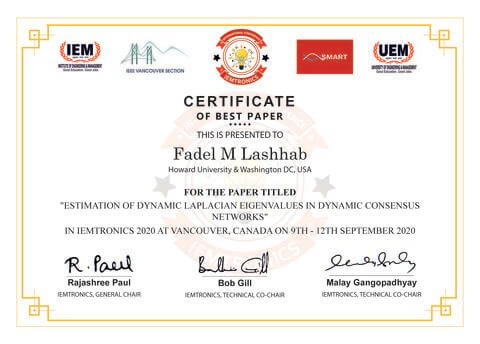Electrical Engineering Lecturer Fadel Lashhab Receives 2020 IEEE IEMTRONICS Best Paper Award

Electrical Engineering Lecturer Fadel Lashhab, Ph.D. recently received the prestigious Institute of Electrical and Electronics Engineers (IEEE), International IoT, Electronics and Mechatronics (IEMTRONICS) Best Paper Award in the Mechatronics track for his paper titled “Estimation of Dynamic Laplacian Eigenvalues in Dynamic Consensus Networks”. IEEE IEMTRONICS is a multidisciplinary international conference that aims to bring together scholars from different backgrounds to recognize current research in the fields of IOT, Electronics and Mechatronics. Research paper submissions describing original works are invited in five tracks: IoT and Data Science, Electronics, Information Technology, Mobile Communication, and Mechatronics.
The use of consensus networks in networking has received great attention due to its wide array of applications in fields such as robotics, transportation, sensor networking, communication networking, biology, and physics. In this research, Dr. Lashhab considered a dynamic consensus network where dynamic links connect integrating nodes. This is a good model for many important systems, such as the electric grid or power grid and building thermal processes and control. Dr. Lashhab developed controller design techniques that can be used to reject disturbances, a critical application feature. Dr. Lashhab’s research has the potential to find a number of uses in applications related to efficient thermal control of buildings and other energy-related systems. These systems, which are best described as cyber-physical systems, are vital to national security as critical infrastructure systems. Dr. Lashhab’s work can help ensure the resilience of these systems.
This award-winning paper shows the development of a method to estimate the bounds of the eigenvalues of a dynamic Laplacian matrix. The Dynamic Grounded Laplacian matrix was defined and then used to obtain the lower and upper bounds for the eigenvalues of a dynamic Laplacian matrix. The estimated bounds of the eigenvalues were later used in the paper to identify the locations of the eigenvalues and then demonstrate the value of these bounds in analyzing the stability of dynamic consensus networks with distributed controllers using the Nyquist graphical-stability test.
